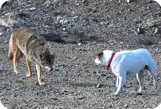One of the keys to coyote's success is their diet. As true scavengers, coyotes will eat almost anything. Identified as a killer of sheep, poultry, and deer, the coyote is an opportunistic predator that will eat snakes and foxes, doughnuts and sandwiches, rodents and rabbits, fruits and vegetables, birds, frogs, grass and grasshoppers, and carrion. Owing to their adaptability, coyotes acclimating to an urban environment can become bolder because they are less likely to be harmed and more likely to associate people with an easy and dependable food source. Near human habitation, coyotes may seek trash and pet food as nutritional resources. In addition to easy access to food waste, coyotes have learned that small dogs and cats are easy prey, including harassing leashed dogs on walks with their owners in and near parks and golf courses within city limits.
Coyote Awareness
Almost no animal in America is as adaptable to changing conditions as the coyote. They can live almost anywhere, and have adapted to a wide range of habitats, including urban inner cities and suburban neighborhoods. Coyotes can be found throughout the United States and are quite common in Utah.

Coyotes have erect pointed ears, slender muzzles, and bushy tails. Most coyotes are brownish-gray in color with a light gray- to cream-colored belly, although colors vary and may be somewhat darker or lighter depending upon geographic region and time of year. Most coyotes have dark or black hairs over their back and tail.
Adult coyotes generally weigh between 20 and 45 pounds. Females are generally smaller than males, and western coyotes are generally smaller than their eastern counterparts. They are mainly active during the night but are also known to move about during the day. Most coyote sightings occur during the hours close to sunrise and sunset.
Preventing Coyote Conflicts
Coyotes are typically timid around people and will generally shy away from them. To reduce the likelihood of encounters with coyotes on your property:

- Do not feed coyotes.
- Remove attractants, including pet food, water sources, and fallen fruit. Bird feeders should be positioned so that coyotes cannot get feed.
- Secure trash in a locked receptacle. Keep trash inside or put it out only on the morning of pickup. Do not discard edible garbage where coyotes can get to it.
- Trim vegetation around your yard to reduce hiding places.
- Do not leave small children outside unattended.
Protect pets and keep them current on their vaccinations.
Help reduce the risk to your pets:
- Supervise pets when they are outside, especially at dawn and dusk.
- Feed pets indoors whenever possible.
- Store pet and livestock feed where it is inaccessible to wildlife.
- Never leave pets outside after dark.
- Keep dogs leashed, especially when on trails and in open areas.
- Never let your dog chase or "play" with coyotes.
- Cats should be kept indoors.
- To deter coyotes, fence your yard with a six-foot high fence. The bottom should extend at least six inches below ground level for best results.
- Secure outdoor pets in a kennel, barn, or shed at night. If that is impossible, a small, well-lit pen close to a structure is the next-best option.
In addition to common household pets, many suburban/semi-rural residents maintain hobby farms and ranchettes, keeping poultry, horses, and other livestock.
With these animals, special considerations should be considered:
- Use net-wire or electric fencing to keep coyotes away from livestock.
- Shorten the length of calving and/or lambing seasons.
- Confine livestock in a coyote-proof corral a night when coyotes are most likely to attack livestock.
- Use lights above corrals.
- Remove deceased livestock so coyotes won't be attracted to scavenge.
- Remove habitats that provide homes to natural prey of coyotes, like rabbits, from lambing and calving areas.
- Actively discourage coyotes from your property. Install strobe lights and sirens to scare away coyotes. Use guard animals such as dogs, donkeys or llamas to protect hobby farm pets and livestock.
Hazing
Coyotes who have become habituated have lost their fear of humans. These emboldened coyotes are more likely to approach homes and should not be tolerated or enticed. Rather, they should be given the message that they are not welcome. This is done by hazing — a method that reinstates a coyotes' fear of humans and deterring them from neighborhood spaces such as backyards and playgrounds. This can be done using a variety of tools, including:
- Yelling and waiving your arms while approaching the coyote.
- Using noisemakers. These can be conventional instruments, including your voice, whistles, air horns, and bells. You can also manufacture noisemakers with soda cans filled with pennies or dead batteries and sealed with duct tape, or improvised noisemakers like pots and pans.
- Using projectiles, such as sticks, small rocks, cans, tennis balls, and rubber balls.
- Other repellents, such as hoses, water guns or spray bottles with vinegar water, pepper spray, bear repellant, or walking sticks.

If a coyote has not been hazed before, it might not immediately run away when being yelled at. If this happens, you may need to walk toward the coyote and increase the intensity of your hazing. If the coyote runs away, it might stop after a distance and look back at you. It is important to continue to haze the coyote until it leaves the area completely. You may need to use multiple tactics, utilizing noisemakers, stomping your feet, and spraying it with a hose to get it to leave.
Hazing is most effective when a coyote is hazed by multiple people using a variety of tools and techniques. Hazing techniques and tools are effective for single animals, or groups. In groups, there is usually a dominant animal who will respond, and others will follow its lead. A coyote who is being hazed must be able to recognize that the potential threat is coming from a person. Therefore, hiding behind a bush and throwing rocks or hazing from inside your car isn't effective.
If a coyote returns after successful hazing, continue to haze it. It typically only takes one or two good times to permanently haze a coyote away. However, if not effectively persuaded to retreat, coyotes and/or their offspring may return to their unacceptable behaviors. By making life difficult for coyotes in your neighborhood, you will increase the likelihood that they will go somewhere else.
In addition to repelling coyotes from your home, several tools for repelling coyotes can be carried while walking your dog, who should always be kept on a leash. If you see a coyote, pick up your dog (if possible) or place it behind you before hazing the coyote. Then:
- Blow a whistle or horn.
- Use a squirt gun.
- Yell and wave your arms.
- Use a homemade noisemaker.
- Pick up sticks or rocks and throw them toward the coyote.
It is important to not retreat from a coyote. However, it is not advisable to approach or interact with a coyote suspected of being sick or injured. Although coyotes generally aren't aggressive towards people, sick or injured animals can behave unpredictably. If you encounter a coyote you suspect is sick or injured, contact Animal Control at (801) 840-4000 and someone will respond if possible. Visit Utah Division of Wildlife Resources for a list of local wildlife nuisance control companies.
